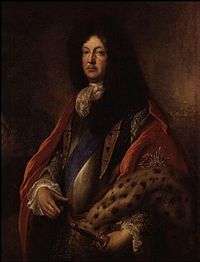Sir William Talbot, 1st Baronet
Sir William Talbot, 1st Baronet (died 16 March 1633), was an Irish lawyer and politician.
Life
He was the son of Robert Talbot of Carton, County Kildare, who was the third son of Sir Thomas Talbot of Malahide, County Dublin; his mother was Jenet FitzGerald, daughter of Thomas Fitzgerald. He was educated for the law, and attained a leading position as a lawyer in Dublin. About 1603 he was appointed Recorder of Dublin, but, being a staunch Roman Catholic, which was a bar to public office he was soon afterwards removed from office for recusancy.
On 13 April 1613 he was returned to the Irish Parliament as MP for County Kildare, and became the unofficial legal adviser to the Roman Catholic party in the Irish House of Commons. Thomas Ryves, a close ally of the new Speaker, complained to the Westminster government that Talbot had abetted the return to Parliament of two schismatics. During the stormy scenes which marked the election of a Speaker in the Irish House of Commons, culminating with one of the rival Speakers (who was an extremely fat man) sitting on the other, Talbot urged that the House should first purge itself of members elected by illegal means. On 30 May he was appointed by the House one of the deputies to represent to James I the corrupt practices employed in the elections to secure a Protestant majority, and the arbitrary treatment of the Anglo-Irish Catholics. He crossed to England in July, and was examined by the Privy Council on his conduct in the Irish House of Commons. During the discussion of this question Archbishop George Abbot demanded Talbot's opinion on a book (probably the Defensio fidei Catholicae adversus Anglicanae sectae errores) in which (he said) Francisco Suárez openly maintained the right of Catholics to kill an heretical king. Talbot hesitated, but acknowledged James as the lawful king. The Council was not satisfied with his answers, and on 17 July Talbot was committed to the Tower of London.
On 13 November 1613 the Star Chamber sentenced him to a fine of £10,000. Early in the following year, however, Talbot was allowed to return to Ireland, and the fine was probably remitted. James I, on releasing him, disclaimed any intention of forcing the Irish Catholics to change their religion. From this time Talbot became a supporter of the government, but took little part in politics. On 4 February 1622 he was created a baronet, and he subsequently received various grants of land. He died on 16 March 1633[1] and is buried in Laraghbryan Cemetery outside Maynooth.
Marriage and children
By his wife Alison, daughter of John Netterville of Castleton, co. Meath, Talbot had issue eight sons and eight daughters. The eldest son, Robert, succeeded as second baronet, and from Robert's daughter Frances, who married Richard Talbot of Malahide, descended the Baron Talbot de Malahide. The second son was Peter Talbot, Archbishop of Dublin, and the eighth was Richard Talbot, 1st Earl of Tyrconnell. Tyrconnel became Lord Lieutenant during the reign of James II, overhauling the Royal Irish Army which then fought in the War of the Two Kings
- Robert;
- Peter; and
- Richard Talbot, 1st Earl of Tyrconnell.

Of Sir William's daughters, Margaret married the landowner Sir Henry Talbot; Frances married James Cusack, grandson of Sir Thomas Cusack, Lord Chancellor of Ireland; Eleanor married Sir Henry O'Neill, 1st Baronet, of Killelagh, and was the mother of Sir Neil O'Neill and of Rose O'Neill, foster daughter and heir-at-law of Rose MacDonnell, Marchioness of Antrim; Mary married Sir John Dongan, 2nd Baronet, and had at least ten children, including Sir Walter Dongan, 3rd Baronet, William Dongan, 1st Earl of Limerick, and Thomas Dongan, 2nd Earl of Limerick.
Notes and references
- Cokayne 1896, p. 444: "RICHARD TALBOT, 5th or 8th son of Sir William Talbot 1st Bart., [I.} of Carton, co. Kildare (d. 16 March 1633), by Alison, da. of John NETTERVILLE, was b. probably about 1625;"
- Cokayne, George Edward (1896), The complete peerage of England, Scotland, Ireland, Great Britain and the United Kingdom, extant, extinct, or dormant, 7 (1st ed.), London: George Bell and Sons – S to T
- Pollard, Albert Frederick (1898), "TALBOT, SIR WILLIAM (d. 1633)", in Lee, Sidney (ed.), Dictionary of National Biography, 55, London: Smith Elder & Co, pp. 338–339
| Baronetage of Ireland | ||
|---|---|---|
| New creation | Baronet (of Carton) 1623–1634 |
Succeeded by Robert Talbot |